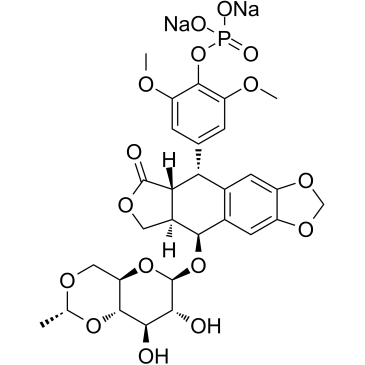Etoposide phosphate disodium
Modify Date: 2024-01-09 09:06:42

Etoposide phosphate disodium structure
|
Common Name | Etoposide phosphate disodium | ||
|---|---|---|---|---|
| CAS Number | 122405-33-8 | Molecular Weight | 712.50 | |
| Density | N/A | Boiling Point | N/A | |
| Molecular Formula | C29H31Na2O16P | Melting Point | N/A | |
| MSDS | N/A | Flash Point | N/A | |
Use of Etoposide phosphate disodiumEtoposide phosphate disodium (BMY-40481 disodium) is a potent anti-cancer chemotherapy agent and a selective topoisomerase II inhibitor to prevent re-ligation of DNA strands. Etoposide phosphate disodium is the phosphate ester prodrug of etoposide and is considered as active equivalent to Etoposide. Etoposide phosphate disodium induces cell cycle arrest, apoptosis, and autophagy[1][2]. |
| Name | Etoposide phosphate disodium |
|---|
| Description | Etoposide phosphate disodium (BMY-40481 disodium) is a potent anti-cancer chemotherapy agent and a selective topoisomerase II inhibitor to prevent re-ligation of DNA strands. Etoposide phosphate disodium is the phosphate ester prodrug of etoposide and is considered as active equivalent to Etoposide. Etoposide phosphate disodium induces cell cycle arrest, apoptosis, and autophagy[1][2]. |
|---|---|
| Related Catalog | |
| Target |
Topoisomerase II |
| In Vitro | Etoposide phosphate disodium is a water-soluble derivative and probable prodrug of etoposide characterized by the presence of a phosphate group in position 4' of the E ring of the etoposide molecule[1]. Etoposide phosphate disodium (0-1 μM; 72 hours) inhibits HCT116 FBXW+/+, FBXW-/- and p53-/- as a dose-dependent manner, exhibits IC50 values of 0.945 μM; 0.375 μM; and 1.437 μM, respectively[2]. Etoposide phosphate disodium (25 μM; 6 hours) delays p53 recover in FBXW7-deficient cells. In addition, FBXW7 expression is disappeared in FBXW7-/- cells[2]. Cell Viability Assay[2] Cell Line: FBXW+/+, FBXW-/- and p53-/- cell Concentration: 0.025 μM, 0.05 μM, 0.075 μM, 0.1 μM, 0.2 μM, 0.4 μM, 0.6 μM, 0.8 μM, 1 μM Incubation Time: 72 hours Result: Inhibited HCT116 FBXW+/+, FBXW-/- and p53-/- cell growth as a concentration manner. Western Blot Analysis[2] Cell Line: HCT116 FBXW7+/+ or FBXW7-/- cells Concentration: 25 μM Incubation Time: 6 hours Result: Exhibited that the recovery of p53 levels after DNA damage is mediated by FBXW7. |
| In Vivo | Etoposide phosphate (intravenous injection; 50, 100, or 150 mg/kg; single dose) has clinical symptomology of progressive ataxia, impaired righting reflex, and splaying and paresis of fore- and hindlimbs at day 8 in female CD-1 mice[3]. Animal Model: Female CD-1 mice[3] Dosage: 50, 100, or 150 mg/kg Administration: Intravenous injection; single dose Result: Observed degeneration of dorsal root ganglion cells and axonal degeneration of their distal and proximal processes in peripheral nerves, dorsal spinal roots, and dorsal funiculi of the spinal cord at all doses under light microscopy (LM). |
| References |
| Molecular Formula | C29H31Na2O16P |
|---|---|
| Molecular Weight | 712.50 |